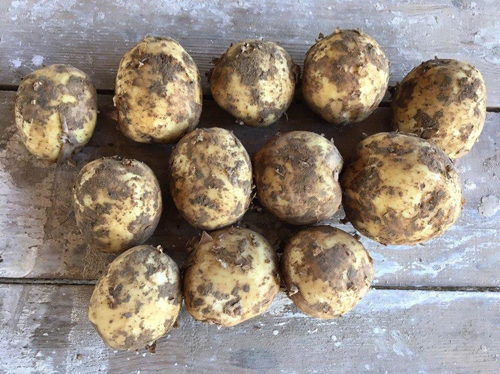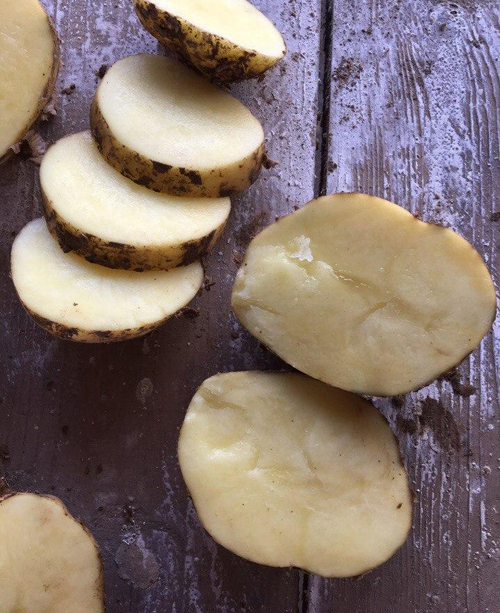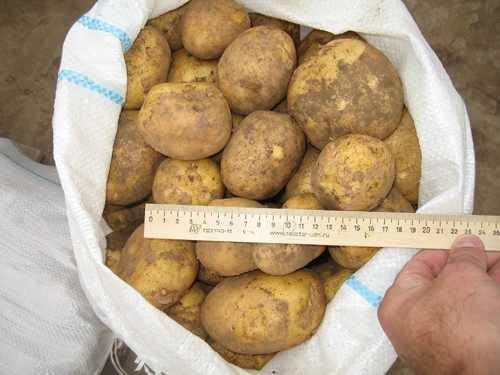Potato variety Veneta (Vineta)
Veneta is an early ripe potato variety (Solanum tuberosum) for table use. Bred by specialists of the German company EUROPLANT Pflanzenzucht GmbH. In 2001 he was included in the state register of breeding achievements of the Russian Federation under the official name "Vineta". Approved for cultivation in six regions of Russia: Central, Volgo-Vyatka, Central Black Earth, North Caucasus, Middle Volga, Ural. Recommended for cultivation in areas with difficult climatic conditions.

The period from the appearance of full shoots to ripening is 60-70 days, but the first harvest can be harvested already on the 45th day of the growing season! Thus, when planting in early May, the first digging can be carried out in mid-June.
The plant is tall, up to 70 cm, spreading. The main stem is erect. Leaves are medium in size, with slight to moderate waviness at the edges, light green in color. The flowers are small or medium-sized, white in color.
Tubers are small, oval or round in shape, weight varies from 67 to 95 grams, starch content 13-15%. The peel is mesh, light or dark yellow in color. The pulp is firm, light yellow in color. The eyes are small, almost invisible, their number is small.
10-12 tubers develop on one plant, their formation occurs together. Marketable yield 160-228 kg / ha, which is 52-68 kg / ha higher than the indicators of varieties Zhukovsky and Bryansk early. When digging on the 45th day after germination, the yield is 127-159 c / ha, which is 10-61 c / ha more than the results of Pushkinets and Bryansky early potatoes, when digging on the 55th day - 155-220 c / ha, by 48-56 kg / ha higher than the standards Zhukovsky and Bryansk early. The maximum recorded yield is 238 c / ha, which exceeds the Volzhanin standard by 57 c / ha. Marketability is high - 87−97%. Veneta is also excellent for transportation and storage, tubers are weakly susceptible to mechanical damage. Keeping quality is 87%.
The taste of the variety is assessed as excellent. It is classified as culinary type B (according to the EAPR - European Association for Potato Research). This means that the tubers are poorly boiled, and therefore are excellent for frying, especially deep-fried, for preparing salads and chips, and are also an excellent ingredient for soups and vegetable mixtures. And for mashed potatoes, these are quite good! It is also noteworthy that the pulp does not darken during heat treatment, so that the finished dish looks very attractive.

From an agrotechnical point of view, Veneta can be considered a very valuable find! In this aspect, it has almost the same advantages. First, it is absolutely not picky about the composition of the soil. Secondly, it can grow in different climatic conditions, while maintaining high yields. Thirdly, plants do not require special attention to themselves during the growing season, with the exception of the most basic elements of care. However, there is one caveat - experts strongly recommend germinating tubers before planting for better germination. Below are the main agrotechnical subtleties that will allow you to achieve maximum yield.
- Calibrate the seed before planting. The most suitable are tubers weighing from 35 to 85 grams.
- The originator recommends planting 44-47 thousand plants per hectare of area, or 440-470 plants per hundred square meters.
- The place for growing the variety must be chosen sunny.
- The optimum depth of the planting holes is 10 cm, the distance between them should be 28-30 cm.The width of the row spacing is 75 cm.
- Tubers respond well to treatment with growth stimulants; the use of fungicides will also be useful.
- During the growing season of plants, as necessary, watering, weeding, loosening and hilling of the soil, as well as top dressing should be carried out. But do not get carried away with nitrogen fertilizers - their high concentration significantly reduces the shelf life of potatoes and impairs its taste.
- Do not neglect maintaining crop rotation.The best predecessors are legumes, cabbage, cucumber, beetroot, green manure, onion, garlic and some other crops.
As for micronutrient feeding, the originator provides a small list of recommendations:
- before planting, it is desirable to apply phosphorus fertilizers to the soil at the rate of 100 kg / ha;
- potash top dressing should be done as needed, depending on the composition of the soil, in approximate doses of 200-250 kg / ha;
- magnesium is applied in the amount of 70 kg / ha, it is preferable to use magnesium sulfate for these purposes.

However, do not forget that the amount of fertilizer applied to the soil must be adjusted for your specific site, based on the characteristics of the type and composition of the soil.
One of the main advantages of Veneta is the independence of the amount of the crop from weather conditions. Plants tolerate drought well, which is why, by the way, this potato has gained wide popularity in Central and South Asia. The following follows from this feature - planting can do without watering for a long time, and this is a huge plus for those gardeners who cannot often travel to their plots.
The cultivar is resistant to many diseases, including cancer, golden potato cyst nematode, banded and wrinkled mosaic viruses, and leaf curling. It is quite susceptible to late blight in terms of tops, while tubers are affected much less often.
With the exception of a few minor flaws, Veneta has a wide range of advantages, the most striking of which are high yield, amicable ripening of tubers, drought resistance and unpretentious cultivation, excellent presentation and, of course, excellent taste. Choosing this potato for cultivation will be an excellent solution for both the amateur gardener and the owner of a large-scale production!
The following companies are officially engaged in the cultivation of this variety: LLC "Elite Potato" in Kazan, IP Kolyasin Sergei Nikolaevich (Omsk), CJSC "Teplichny" in the Omsk region, LLC "Alrost" in the city of Novocheboksarsk, LLC "Teplichno-greenhouse Combine "Elita-Potato" "Omsk region., LLC" Aksentis "Nizhny Novgorod region. "Vperyod", Spassky District, SPK "Dubensky", Nizhny Novgorod Region, LLC "Udmurtsoyaprodukt", IE Yachmenev Oleg Igorevich, Federal State Budgetary Scientific Institution "VNII Potato Economy named after A. G. Lorkha ", Federal Research Center" Kazan Scientific Center of the Russian Academy of Sciences "", LLC "Latkin", KFH "Egorsha" Tula region., LLC "Elithoz" Nizhny Novgorod region., LLC "Rassvet-Novy" Kaliningrad region








